ISSN ONLINE(2320-9801) PRINT (2320-9798)
ISSN ONLINE(2320-9801) PRINT (2320-9798)
M.S. Kanitkar 1 , S.Prabhu 2 , Rahul Chauhan3, Akhileshbhat 4
|
| Related article at Pubmed, Scholar Google |
Visit for more related articles at International Journal of Innovative Research in Computer and Communication Engineering
Swarm Technology is basically a system which works on real time conditions and the members in the group interact with each other in a decentralized manner to achieve a particular objective via self -organization. Natural examples are ant colonies, schooling of fishes, etc. Swarm intelligence is a field of artificial intelligence. Artificial Intelligence of machine or software is that which studies and develops intelligent machine and software to make day to day life of humans much easier. Swarm behavior is a collect ive behavior exhibited by similar types of species which all together perform a particular task. Till date swarm technology is been used only for robot -to-robot implementation. We are using swarm technology in which it uses Nano bots to do a specific dedicated task. Basically this concept works on hierarchy of three stages in the manner Coordinator (mahaguru), Router (guru) and End device (bhakt ) which work in a coordinated manner and can take their own decisions. Now in our project we are implementing this swarm tech nology for the purpose of traffic control by signal-to-signal control. Currently the systems that are implemented are based on fixed t imers or fixed length signals leading to traffic jam. The fixed length timers can be used in smaller areas of low traffic, but for larger area or dense traffic junctions can lead to congestion. Our aim is to reduce this problem by implementing the variable timers. Depending upon the density of traffic, the adaptive timers will be set by using various algorithms. We are develo ping a scalable and distributed algorithm which can easily adapt the traffic signal plans. This project will also develop a realistic traffic signal development plans. Also safety will be given top priority in our system.
Keywords |
| Coordinator (Mahaguru), End device (Bhakt), router (Guru), swarm technology, |
INTRODUCTION |
| Approaches to reduce traffic jams have been proposed in several disciplines like transportation engineering, physics, and artificial intelligence, among others. A classical one is to coordinate or synchronize traffic lights so that vehicles can traverse an arterial in one traffic direct ion, with a specific speed, without stopping. |
| Thus, coordination here means that if appropriate signal plans are selected to run at the adjacent traffic lights, a “green wave” is built so that drivers do not have to stop at junctions. There are several reasons why this approach may fail. In traffic networks without well-defined traffic flow patterns, like for instance morning flow towards downtown and it is similar in afternoon rush hour, that approach may not be effective. This is clearly the case in big cities where the business centres are no longer located exclusively downtown. Traffic patterns can also be affected by accidents, floods, snow, etc. Finally, a priori determination of the appropriate signal plans for the different times of a day is a complex task that requires a lot of knowledge about dynamic traffic flow. These issues show that simple offline optimization of the synchronization in one arterial alone cannot cope with changing traffic patterns. This happens because traffic is a highly dynamic process, thus the currently optimal signal plan can hardly be determined in advance. With an increasing volume of traffic, this situation becomes more and more unacceptable. Thus, flexible and robust approaches are not only attractive, but necessary. Our approach seeks to replace the traditional way of dealing with the traffic that occurs in heavily crowded cities. Of course in some key junctions conflicts may appear because in almost all practical situations, a signal plan do not allow synchronization in more than one traffic direct ion. |
| However, our approach dynamically deals with the question of which traffic direct ion shall be synchronized. Decentralized systems, and especially swarm intelligence offer more flexible solutions. So we provide an approach in which each junction (plus its traffic lights) behaves like a social insect goes hand in hand with other junctions which can be considered as other insects, thus collectively as a swarm of insects. Henceforth we use the terms crossing, junction, and traffic light indistinctly. Signal plans are seen as tasks to be performed by the insect. |
RELATED WORK |
| In [1] the author has done a survey of vehicular t raffic increase in India. In the survey he has noted down the day by day the population is increasing, the number of vehicular use is also increasing. Thus he has inferred that as the rate at which vehicular use is increasing is double the rate at which population is increasing. In [2] author proposed to address situations where optimum optimizat ion strategies change with traffic conditions . It carried an important advantage that makes it robust under communication difficulties.In [3] authors make the use of Sensor Networks along with Embedded Technology. The current scenario of the traffic is given and the solutions of the traffic problems are also mentioned. Auto routing feature is one of the solutions. In [4] authorspresented an idea that can be implemented in traffic safety by the application of Robotics & Computer Vision through Swarm Intelligence. |
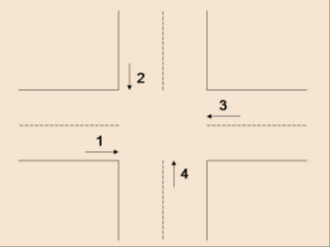 |
| Fig.1 shows a crossroad of 4 lanes |
| Considering the traffic intersection in real life, we are considering ideal junction of four roads, each road being two ways and each way having the width of two cars. All cars in any street are able to turn around in any direction as per the need. One signal is green while others are red; this is the state of signals at any moment to allow t he vehicles of one lane to pass through the traffic in any direction. |
PROPOSED SYSTEM |
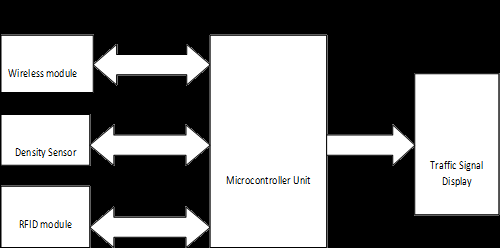 |
| Fig. 2 shows a proposed block diagram |
| Microcontroller unit plays an important role for controlling traffic signal. The input to the microcontroller is from density sensor, wireless module and RFID module. Density sensor will detect the density of traffic on each respective signal. For this purpose we are using IR sensor. Depending on the density the timing of the signal will be adjusted. Wireless module will facilitate the communication between each adjacent traffic signal, so as to take required action. RFID module is used for the priority purpose so as to solve the emergency problems. For e.g.: Ambulance, Fire - brigade, VIPs etc. |
| The feature in this thesis, |
| • Density based: Depending on the density of the traffic the toggling time of the traffic signal from red to green gets varied. |
| • Priority based: Priority to the odd vehicles for e.g. ambulance, fire brigade, V.I.P vehicles, etc. are given and are allowed to pass through the traffic without wasting their time in the traffic. |
| • Vehicle auto routing: If there are two different routes to the next crossroad, the traffic can be diverted efficiently by displaying the time taken to reach the next crossroad through those two routes separately, so that the traffic in one particular lane of the destination crossroad will be avoided. |
| A. Density based |
| We are using IR sensors for sensing the intensity of traffic at a particular lane. IR sensors have a transmitter (Tx) and a receiver (Rx). Receiver will detect the light that gets deflected from the obstacle which in our case is vehicle and the light being transmitted by the transmitter |
| We are placing 2-4 sensors on the left lane depending on the types of vehicles using the road, e.g. 2 sensors if two wheelers and 4 wheelers use the lane, 3-4 sensors are used if heavy vehicles like truck, buses use the lane. Depending on the vehicles coming on the lane the sensors are placed at a standard distance from each other to sense light as well as heavy vehicles efficiently. |
| In every sensor board we are using two pairs of Tx and Rx which are connected to Op -Amp LM317 which we are using as a comparator, whose compared output is given to the microcontroller. If one sensor board, having two sensors is used, then there are 3 conditions it can give to the microcontroller like |
| • No Tra ffic (“ 00”). |
| •Low (“ 10” ). |
| • High (“ 11”). |
| The binary values are the output of the sensors which is given to microcontroller for the three different traffic conditions. |
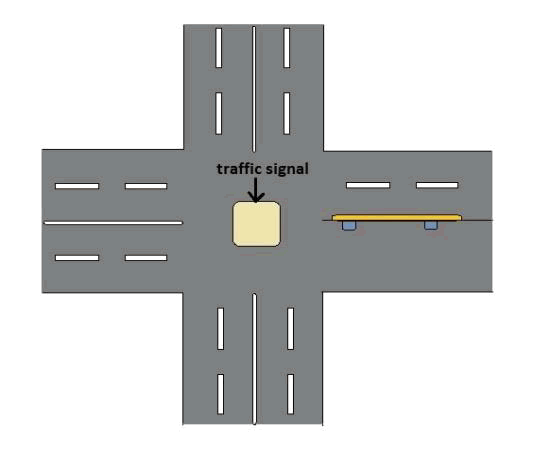 |
| Fig.3 Shows No Traffic |
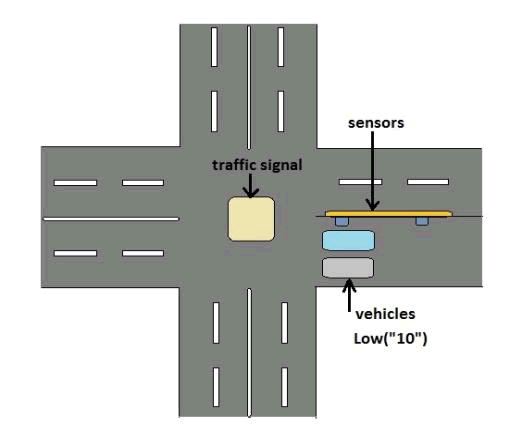 |
| Fig. 4 Shows Low Traffic |
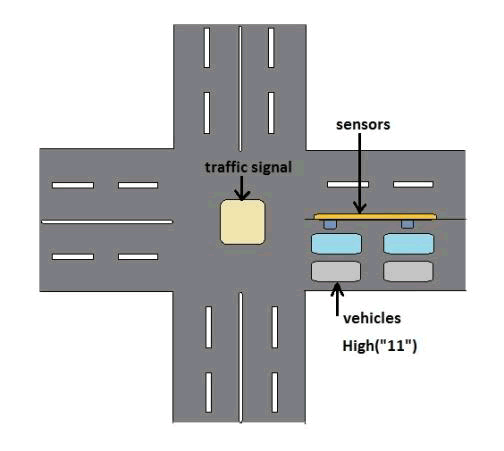 |
| B. Priority based |
| The odd vehicles like ambulance, V.I.P vehicles, Fire brigades, etc. are to be given higher priority and services when they arrive at a crossroad to reach their destination in emergency cases. They shouldnâÃâ¬ÃŸt waste their time getting held up in the traffic signals. |
| For that we are providing a tag (unique code) to these odd vehicles and also placing RFID readers at the traffic signal cross roads. |
| Now, when these important vehicles with their unique tag arrives near the traffic crossroad the RFID reader reads the unique code and sends it to the microcontroller in which the tag code is compared with the stored code in the memory of microcontroller, and then if the code matches the microcontroller recognizes that the vehicle that has reached the signal is an important vehicle, that may be ambulance, or anything else, depending upon the code that is stored in the microcontroller. After recognizing the vehicle and its type, the microcontroller gets an interrupt i.e. it stops executing whatever it was executing and starts performing the program written in the ISR (Interrupt Sub -Routine). The program written in ISR will be nothing but to toggle the signal from red to green of that respective lane in which the important vehicle has arrived and makes the signal of other lanes red. |
| By doing so we are trying to help the important vehicles in the city to get through the traffic jams and to reach their destination even faster. |
| C. Vehicle Auto Routing |
| For this we are implementing a public display at the signal cross roads. It displays the updates of the traffic intensity at neighbouring crossroads and also the time that will be taken by the rider to reach the next crossroad through various routes. |
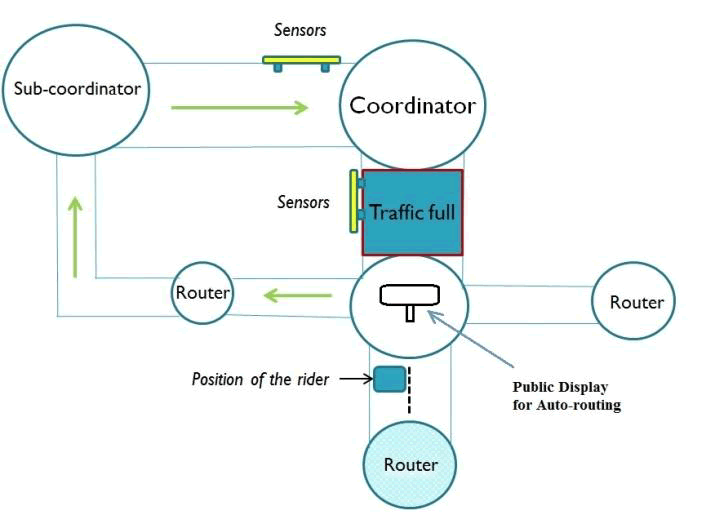 |
| Fig. 6 Shows the Working of Auto Routing |
| Consider a person driving vehicle reached the cross road „AâÃâ¬ÃŸ and is at the position of the rider as shown in the Fig. 6. Then as the display is updated with the timing that will incur if gone straight or left to reach the next Coordinator cross road. The timing displayed will be totally on the basis of the traffic intensity or the state of the sensors at the coordinator as shown in Fig. 6.As shown if the traffic is full at the straight lane of coordinator and no traffic at the left side lane, then the display would show the timing as shown in Fig. 7.The informat ion about the traffic intensity and the sensor updates of coordinator crossroad is updated to „AâÃâ¬ÃŸ crossroad frequently by wireless commu nication using Xbee module. |
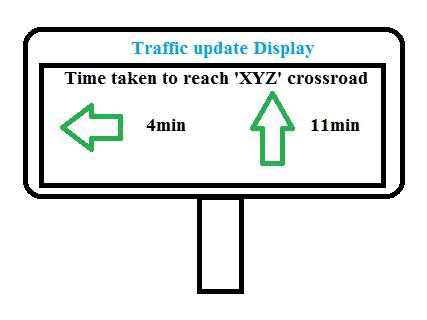 |
| Fig. 7 |
IV. SIMULATION RESULTS |
| Simulation of the algorithm is done using Proteus software.Below Fig. 8 shows the simulat ion done in Proteus software for the condition of no traffic. Which means when there is no traffic in any of the lane of the crossroad; all the traffic signal will be RED, which will be the default condition. |
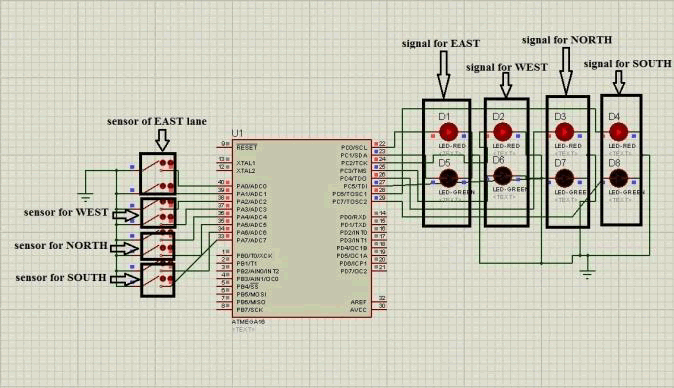 |
| Fig. 8 Shows Simulation done for No Traffic |
| Now as soon as any vehicle traffic reaches near the cross road, depending upon the timing the vehicle traffic reaches and the sensors senses the vehicle the traffic signal will serve that particular lane on the basis of firs t come first serve by switching to GREEN for the time according to the traffic intensity. |
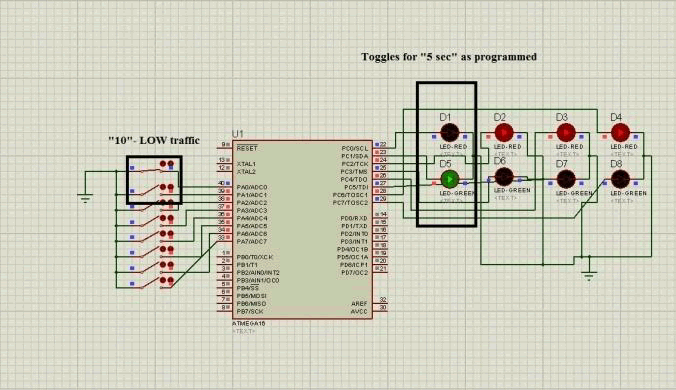 |
| Fig. 9 Shows Simulation done for Less Traffic |
| So when the traffic intensity is low which means only the first sensor of EAST lane gets activated which is depicted by switching the first switch ON in the stimulation Fig 9, the traffic signal of EAST lane will toggle to green for short duration according to the program. |
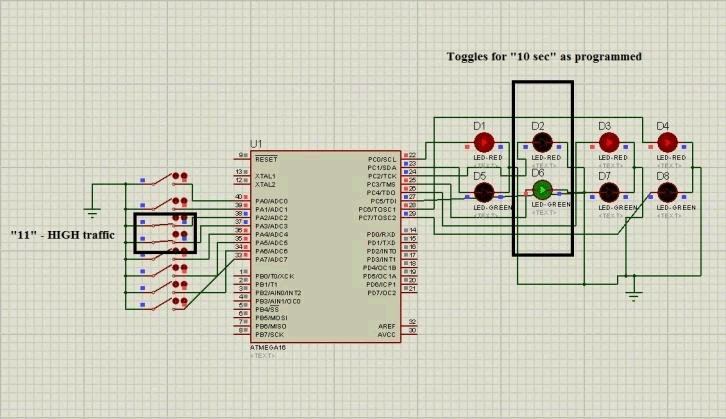 |
| Fig. 10 Shows Simulation done for High Traffic |
| Now when there is a high traffic at WEST lane both the sensors of the lane gets activated which is depicted as two switches switching ON in the stimulation Fig 10, the traffic signal of WEST lane will toggle to green for longer duration according to the program |
V. CONCLUSION AND FUTURE WORK |
| By this project the problem of traffic can be easily sorted out: the timing of each signal can be automatically adjusted according to density of traffic which is real time operation. It will also clear the path fo r the ambulance, fire brigade in emergency cases. And also it will help public in taking decisions for reaching their destination in time using auto - routing method |
| If necessary, GUI system can be implemented so that traffic signal will be controlled manually at the traffic control station. Circuit break detection can be added, which will help us to know the working of sensors, i.e. whether the sensors are working properly or not and if broken a signal to the nearby control centre will be sent so that an immediate back up can be arranged. |
References |
|